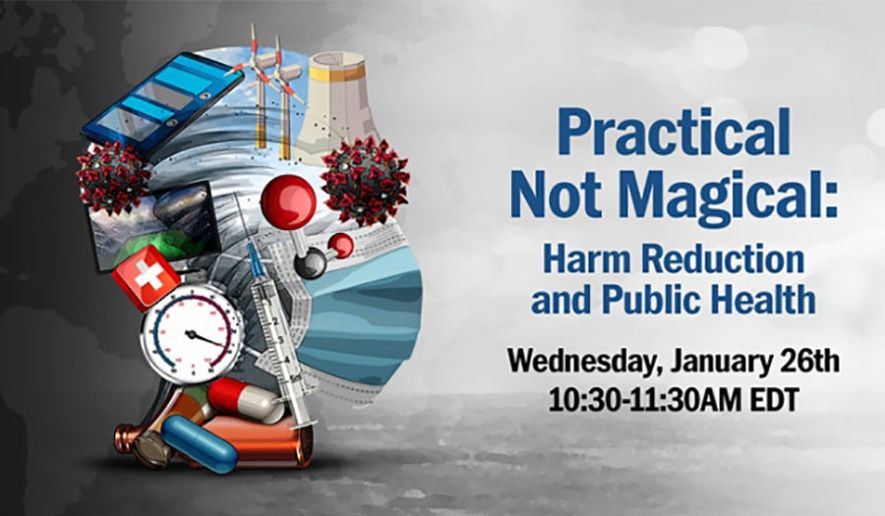Policymakers can decriminalize drugs or offer a safe supply to addicts, so that they don’t die from illicit drugs, taxpayers don’t bear the costs of incarceration, and police and bystanders aren’t placed at risk in “no knock” drug raids.
Regulators should authorize e-cigarettes for adults looking to wean themselves off more harmful tobacco products instead of banning vapes outright, and Western powers should use carbon-capturing technology to clean the atmosphere while they cut emissions and shift to cleaner fuel options.
These are some of the ways policymakers can reduce harm from activities and behaviors that are risky but endemic to society, while avoiding heavy-handed policies or prohibitions that tend to backfire, according to panelists at a virtual event Wednesday hosted by The Washington Times and CollaborateUp.
“While the intentions of governments both here and abroad may be noble in addressing drug use and other risky behaviors, the first point of action should be a realization that silver bullet solutions do not exist,” said Mazen Saleh, policy director for Integrated Harm Reduction at the R Street Institute, a Washington-based think tank.
Harm reduction policies tend to be politically polarizing — leaders don’t want to be labeled soft on crime, for instance, or give a greenlight to vaping even though it is less harmful than regular cigarettes. Yet panelists said all-or-nothing tactics and bans on risky behaviors aren’t working, so it is time to focus on holistic approaches that chip away at risks and save lives.
“We are never going to eliminate substance use disorder. We’re never going to eliminate crime. Our role as policymakers is to implement policies that mitigate the harms to not just individuals, but all our communities,” said retired California police Lt. Diane Goldstein, executive director of the Law Enforcement Action Partnership.
People employ harm reduction tactics every day, such as wearing a seat belt or calling a cab if they’ve had a few drinks and shouldn’t drive. In the policy sphere, efforts to reduce harm usually focus on reducing risks from drug use or sex.
Dr. Imane Kendili, a Moroccan psychiatrist and addiction specialist who recently co-wrote “Harm Reduction — The Manifesto,” said policymakers should “stop fighting” and realize that people will always engage in risky behaviors.
“They have desires, they have behaviors that can be harmful to their health,” Dr. Kendili said.
Regular citizens must do their part alongside policymakers, starting with collective actions to slow climate change, the panelists said.
“Local companies can make decisions to avoid harming the planet through their procurement policies and investments. Governments have to apply the urgent actions that are laid out in the Paris Climate accords and ensure a reversal of the most consequential impacts both at national and local levels. Individuals, of course, have a role to make choices that benefit the planet,” said Kye Young, vice president of partnerships and development at the Foundation for Climate Restoration.
“We’re never going to eliminate fossil fuels or carbon emissions in the atmosphere,” Mr. Young said. “There are ways to mitigate. There are ways to find other, alternative resources — energy resources and power that are safe.”
Partisan politics is a key impediment to harm reduction policies, panelists said.
People on the political left tend to support drug-harm reduction and comprehensive sex education instead of abstinence-only instruction, while those on the right tend to promote tobacco alternatives such as e-cigarettes but not other forms of harm reduction.
“The primary piece of trying to make it apolitical is showing policymakers what is going on in their state, right?” Mr. Saleh said. “Who is affected, what their constituency is dealing with and suffering from and then showing other alternatives than either complete prohibition or incarceration or some of these heavy-handed kinds of interventions that have been proven time and time again to be ineffective.”
In her work, Ms. Goldstein tries to bridge the gap between police and treatment programs. She said needle exchange services and safe-use sites can help divert people from the criminal justice system and reduce overall risk to officers and society.
Incarcerating people costs tons of tax dollars, she said, and sites that offer “safe supply” drugs will keep people from buying heroin laced with an unknown quantity of deadly fentanyl.
“It’s not soft on crime, it’s actually smart on crime because by introducing harm reduction interventions, we save police officers’ lives. We’re not sending cops into no-knock warrants, and having the potential for them being killed or killing someone — like we did with Breonna Taylor,” she said, referring to a 26-year-old woman who was fatally shot when police entered her Louisville, Kentucky, apartment as part of a drug operation and exchanged fire with Taylor’s boyfriend.
Panelists said everyday people can promote harm reduction by staying engaged. For instance, if they support harm reduction strategies, they should oppose efforts to eliminate addiction programs or ban lower-risk tobacco products.
“Citizens in the U.S. underestimate some of the impact that they can have on local elections and legislation,” Mr. Saleh said. “So make your voice heard, attend hearings, things like that, because these are essentially your communities, right? And so as being a responsible citizen, it’s you [who] have to engage in the protection of your communities.”
Wednesday’s event was supported by MAPA (the Moroccan Association of Addiction Medicine and Associated Pathologies), Aphorisme Consulting, Orion Medias, the R Street Institute and Philip Morris International.
The Washington Times and CollaborateUp plan to hold a second event on harm reduction in February.
• Tom Howell Jr. can be reached at thowell@washingtontimes.com.




Please read our comment policy before commenting.